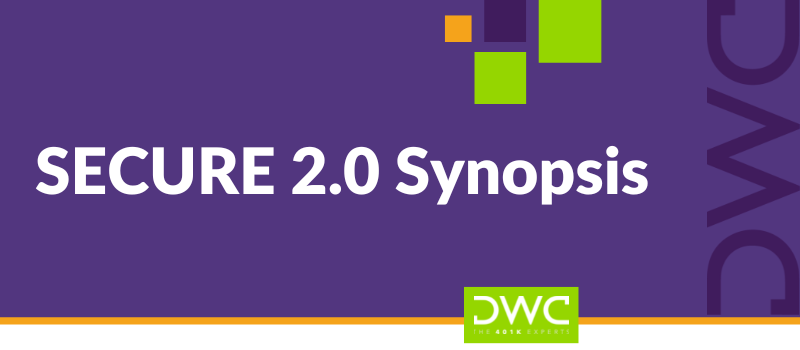Required Minimum Distributions FAQs

What are required minimum distributions (RMDs)?
When a taxpayer reaches age a certain age, he or she must begin withdrawing minimum amounts from all tax-favored retirement accounts each year. This includes both company-sponsored retirement plans, like a 401(k), as well as IRAs.
Thanks to a new law called the SECURE Act, which was signed into law on December 20, 2019, we are in a transition period as to what that “certain age” is.
- For participants with birth dates on or before July 1, 1949, the RMD start date is based on when they reach age 70 ½.
- Taxpayers with birthdays after July 1, 1949, are subject to the new rules and have an RMD start date based on when they reach age 72.
Throughout the remainder of this FAQ, when we refer to participants who are age 72, we are also referring to those who reached age 70 ½ on or before December 31, 2019.
What is the point of this requirement?
In short, taxes. The tax benefits afforded to certain types of retirement accounts are there to incentivize people to save for their retirement. Those benefits are often in the form of a tax deferral, meaning that amounts are deductible when contributed to the plan and taxable at the time of withdrawal. Congress was concerned that these accounts could be used as a way to permanently avoid taxation if the funds accumulated there indefinitely. The RMD rules address this by requiring that a portion be withdrawn each year.
Who is required to receive a required minimum distribution from a qualified plan?
The RMD rules apply to taxpayers who are at least age 72; however, there are some additional nuances depending on whether the retirement account is an IRA or a company-sponsored retirement plan.
IRA
These are fairly straightforward. Anyone who is age 72 and has an IRA is required to take an RMD.
Company Sponsored Retirement Plans
The requirement to take an RMD depends on whether the individual in question is an owner of the company and whether he or she is still actively employed.
- Ownership: Any individual who owns more than 5% of the company that sponsors the plan as of the date he or she turns age 72 must begin taking RMDs regardless of their ongoing employment status.
- Employment Status: For non-owners as well as those who own 5% or less of the company, the RMD requirement kicks in as of the later of the date the participant reaches age 72 or the date he or she terminates employment. That means a non-owner who is 72 does not have to start taking RMDs as long as he or she remains actively employed by the plan sponsor.
It should also be noted that if a participant who is age 72 passes away, his or her beneficiary may be required to take RMDs even though that person might be under age 72.
Note: For active participants who reached age 70 1/2 on or before December 31, 2019, the RMD requirement kicks in on April 1st of the year following the later of the year the participant reached age 70.5 or the year he or she terminates employment.
How is the amount of the RMD calculated?
There are a couple of factors that go into the calculation: the total value of the participant’s account and a life expectancy table published by the IRS. There are several variations of the life expectancy table, but in virtually all RMD calculations, the Uniform Lifetime Table is used.
- Account Value: Use the value as of the last day of the previous plan year. For example, use the value as of December 31, 2019 to calculate the RMD for 2020.
- Uniform Lifetime Table: Use the factor that corresponds to the participant’s attained age for the year of the RMD. For example, for the 2020 RMD, use the factor the corresponds to the participant’s age in 2020. The factor for someone who is 70 ½ is 27.4, and it gradually decreases for each subsequent year.
The RMD amount is simply the account value divided by the factor from the table.
Note that if a participant’s sole beneficiary is his or her spouse and that spouse is more than 10 years younger, the Joint Life and Last Survivor Expectancy table should be used.
What is the deadline for taking the RMD each year?
RMDs are due by December 31 of each year; however, for the year a participant first turns age 72, the initial RMD deadline is not until April 1st of the following year. For example, a participant who reaches age 72 in 2022 has until April 1, 2023 to take his or her first RMD, with each subsequent RMD paid by December 31 of each year.
It is important to note that that same participant is also required to take an RMD for 2023 no later than December 31, 2023. That means he or she ends up taking two RMDs in the same year and then a single RMD in each year thereafter.
Important Note: Work with your recordkeeping service provider or platform provider to process distributions timely, as most platforms will have a deadline of mid-December to ensure the checks can be processed and delivered before the end of the plan year. Your recordkeeping service provider, platform, TPA, or investment advisor is not authorized to approve or process an RMD without a distribution form.
What if the RMD is not processed in a timely way?
The penalty for failure to timely take an RMD is 50% of the amount that should have been distributed, and it is assessed against the taxpayer.
The taxpayer can ask the IRS to waive the penalty by filing Form 5329 along with a letter of explanation. Taxpayers should work with their accountants or other tax advisors for assistance in requesting the waiver. In some circumstances, if the delay is due to an oversight on the part of the plan sponsor, it may be possible to request a waiver of the penalty via the IRS Voluntary Correction Program.
Is it possible to rollover an RMD to an IRA?
No, RMDs are not eligible for rollover since moving them from one tax-deferred account to another would defeat the purpose of the RMD in the first place. However, to the extent a participant takes a distribution for more than the RMD amount, the additional portion can generally be rolled over.
Is there mandatory tax withholding from RMD?
Because an RMD cannot be rolled over, the mandatory 20% tax withholding does not apply. Rather, the default withholding rate is 10% of the RMD amount; however, a participant can elect to have more or less withheld, and may even choose to waive withholding altogether. Absent a specific employee election to the contrary, the default withholding should be 10%.
If a participant has several IRAs and company-sponsored retirement accounts, can they all be combined with the RMD taken from a single account?
It depends on the types of accounts in question. Company-sponsored plan accounts cannot be combined. The participant must take a separate RMD from each such account, and the amount is calculated separately for each plan.
However, if a taxpayer has multiple IRAs, it is possible to take the aggregate RMD due (based on the combined balances in all the IRAs) from one IRA account. But, the qualified plan RMDs must still be paid separately and cannot be aggregated with the IRAs.
My plan has a participant that has reached the minimum age requirement for an RMD. Do you have a sample letter that we can customize and send to our participants?
Yes! Click here to download a sample letter in Word format for participants who have reached the applicable RMD age.












